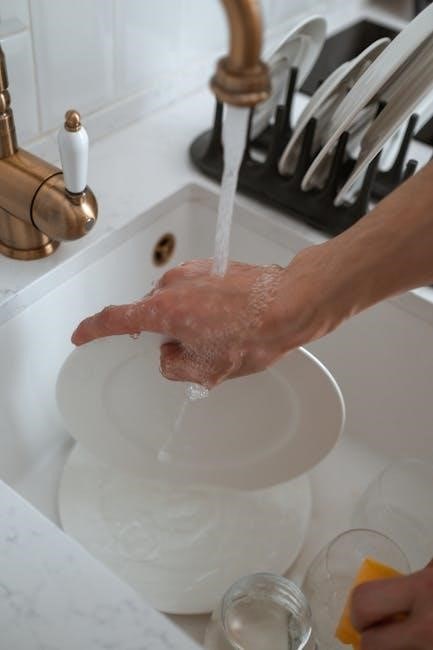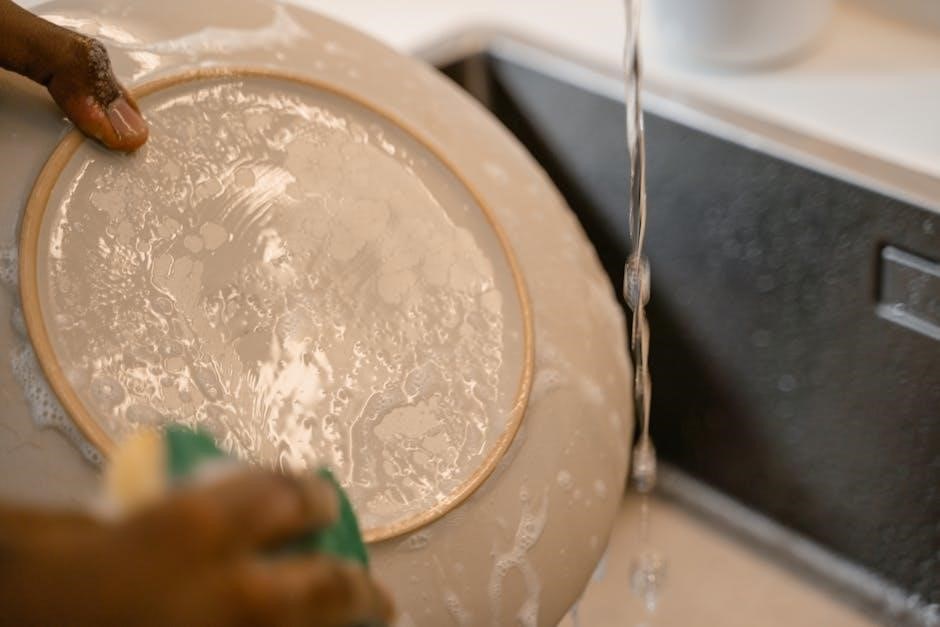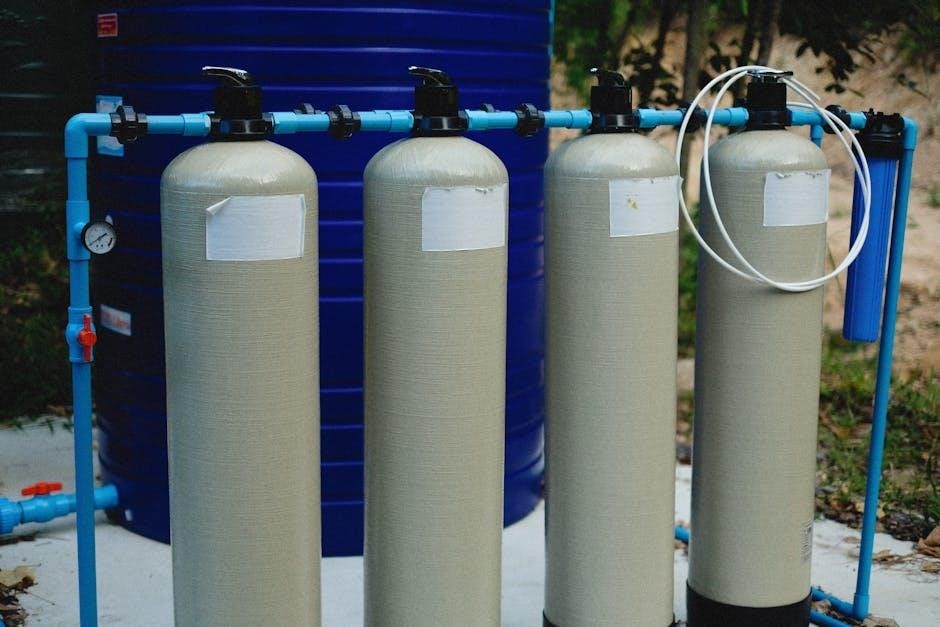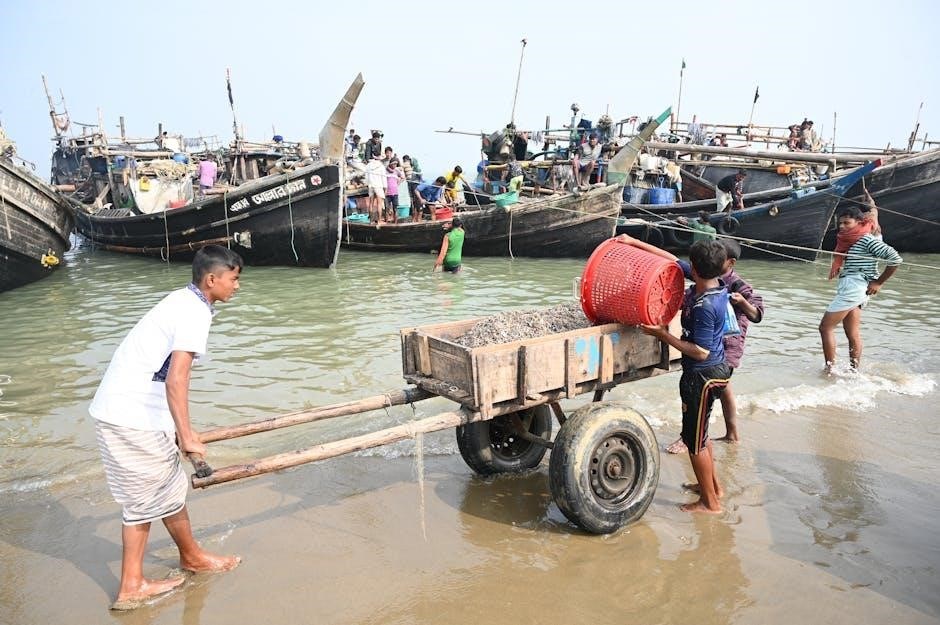A manual water pump is a hand-operated device required for boats between 9 and 12 meters‚ ensuring safety by removing water from bilges efficiently in emergencies.
Definition and Purpose
A manual water pump is a hand-operated device designed to remove water from a boat’s bilge‚ ensuring stability and preventing capsizing. Its primary purpose is to provide a reliable‚ non-electric means of extracting water in emergency situations‚ such as flooding or electrical pump failure. Simple in design‚ these pumps are essential for maritime safety‚ particularly for sailboats and powerboats between 9 and 12 meters in length. They are easy to operate‚ making them accessible for immediate use when needed. The pump’s functionality ensures compliance with safety regulations‚ safeguarding both the vessel and its occupants from potential hazards at sea.
Historical Use and Reliability
Manual water pumps have been used for centuries‚ providing a dependable method for water extraction in various settings. Their simplicity and effectiveness have made them a cornerstone in maritime and rural applications. Historically‚ these pumps were essential for draining water from boats‚ preventing capsizing and ensuring vessel stability. Their reliability lies in their mechanical design‚ which requires no electricity‚ making them indispensable during power failures or emergencies. Over time‚ manual pumps have proven durable and low-maintenance‚ earning their reputation as a trusted tool for water removal. Their historical significance underscores their continued importance today‚ particularly in off-grid and emergency scenarios where modern technologies may fail.
Importance in Rural and Off-Grid Settings
Manual water pumps are vital in rural and off-grid areas where electricity is scarce. They provide a reliable means of accessing water for drinking‚ irrigation‚ and household needs. Their simplicity and durability make them ideal for communities relying on wells or ponds. Unlike electric pumps‚ manual pumps require no fuel or power‚ ensuring continuous water supply during outages. Additionally‚ they are cost-effective and low-maintenance‚ making them a sustainable solution for remote regions. Their role in supporting daily life and agriculture highlights their significance in these settings‚ where they remain an essential tool for water management and self-sufficiency.

Manual Water Pumps and Marine Safety
Manual water pumps are essential for marine safety‚ preventing water accumulation in bilges and ensuring vessel stability. They are crucial for emergency situations‚ especially when electric pumps fail.
Role in Preventing Accidents
Manual water pumps play a critical role in preventing accidents by effectively removing water from bilges‚ ensuring vessel stability‚ and preventing capsizing. They serve as a reliable backup when electric pumps fail‚ especially during emergencies like flooding or system malfunctions. By quickly eliminating accumulated water‚ these pumps reduce the risk of accidents caused by excess weight or compromised buoyancy. Their ability to ensure rapid water removal is essential for maintaining control of the boat‚ particularly in rough conditions. This makes them a vital safety tool‚ contributing significantly to the overall safety of passengers and crew on board‚ and helping to prevent potential maritime disasters. Their reliability is unmatched in critical situations.

Ensuring Compliance with Safety Standards
Manual water pumps must meet specific safety standards to ensure compliance with maritime regulations. These standards dictate requirements such as pump capacity‚ flow rate‚ and installation guidelines‚ ensuring reliable performance in emergencies. For boats between 9 and 12 meters‚ carrying a manual water pump is mandatory to comply with safety laws. The pump must be capable of discharging water efficiently‚ with a minimum flow rate specified by regulations. Proper installation and maintenance are also critical to ensure the pump operates correctly. Failure to comply with these standards can result in penalties and fines‚ making adherence essential for legal and safe boating practices. These requirements help maintain the integrity and safety of the vessel‚ ensuring compliance with both local and international maritime regulations.
Reliability in Emergency Situations
Manual water pumps are indispensable in emergency situations‚ offering a reliable means of removing water when electric systems fail. Their simplicity ensures functionality without power‚ making them critical for boat safety. Designed to operate manually‚ these pumps provide immediate action to prevent water accumulation‚ which could lead to capsizing. Their durability and ease of use make them a vital backup solution‚ ensuring water can be discharged quickly and effectively. In emergencies‚ manual pumps prove essential for maintaining vessel stability and passenger safety‚ highlighting their importance as a dependable tool in maritime safety protocols. Their reliability ensures peace of mind for boat operators in critical moments.

Regulatory Requirements
Manual water pumps are required for sailboats and powerboats between 9 and 12 meters‚ with specific capacity and flow rate standards to ensure compliance and safety at sea.
Length and Capacity Requirements for Sailboats and Powerboats
Regulations specify that sailboats and powerboats between 9 and 12 meters in length must carry a manual water pump to ensure safety; The pump’s capacity and flow rate are critical‚ with requirements varying by boat size. For instance‚ boats over 19.8 meters require a minimum flow rate of 190 liters per minute (LPM)‚ while smaller vessels may need as little as 38 LPM. Proper sizing ensures efficient water removal in emergencies. Smaller boats under 9 meters may use a bailer instead‚ provided they meet specific volume and diameter criteria. Compliance with these standards is essential for preventing accidents and ensuring vessel stability. Proper pump sizing is non-negotiable for safety.

Exemptions for Self-Bailing and Sealed Hulls
Self-bailing and sealed hulls are exempt from manual water pump requirements due to their design‚ which prevents water accumulation. Sailboards and paddle boats‚ with recess-type cockpits‚ naturally drain water‚ eliminating the need for a pump. These hulls ensure stability without additional drainage systems‚ making them safe even in rough conditions. The exemption applies because such boats cannot hold enough water to capsize‚ ensuring safety without manual intervention. This design-focused rule reduces regulatory burdens while maintaining safety standards‚ highlighting the importance of innovative hull designs in maritime safety. Owners of such vessels still benefit from inherent safety features‚ aligning with overall boating safety goals.
Minimum Capacity and Flow Rate Specifications
Manual water pumps must meet specific capacity and flow rate requirements to ensure effective water removal. For boats between 9 and 12 meters‚ the pump’s capacity and flow rate are critical for safety. Regulations specify that larger boats require higher-capacity pumps to remove water quickly in emergencies. For instance‚ boats over 19.8 meters need a minimum flow rate of 190 liters per minute (LPM)‚ while smaller boats may require as little as 38 LPM. These specifications ensure that boats can handle emergency situations efficiently. Proper sizing is essential to meet these flow rate requirements‚ ensuring reliable performance and compliance with safety standards. This focus on capacity and flow rate underscores the importance of manual pumps in maintaining vessel safety.

Design and Functionality
Manual water pumps are designed with durable‚ corrosion-resistant materials for longevity and efficiency‚ ensuring reliable water extraction in various marine conditions and emergency situations effectively always.
Key Components of Manual Water Pumps
Manual water pumps consist of a cylinder‚ piston‚ and handle‚ designed to create suction and force water through a hose. A check valve ensures one-way flow‚ preventing backflow. The hose must be long enough to reach the bilge and discharge water overboard. These components work together to provide efficient water extraction‚ essential for maintaining boat stability. Durable materials like stainless steel or bronze are often used to resist corrosion and ensure longevity. Proper installation and maintenance of these parts are critical for reliable operation in emergency situations‚ making them vital for marine safety and compliance with regulations. The design ensures ease of use and effectiveness in removing water quickly and safely.
Operating Principles
Manual water pumps operate by creating suction to draw water into a cylinder through a hose. A piston or diaphragm moves up and down‚ driven by a handle‚ to generate pressure. This motion forces water through the discharge hose and overboard. A check valve ensures water flows only in one direction‚ preventing backflow. The pump must be primed with water to start operation‚ and the hose should be positioned to reach the bilge. Regular maintenance‚ like lubricating moving parts‚ ensures smooth functionality. The simple‚ mechanical design provides reliable water removal‚ making manual pumps indispensable in emergency marine situations where electric systems may fail. Their effectiveness depends on proper technique and consistent upkeep.
Material Durability and Corrosion Resistance
Manual water pumps are constructed from durable materials like bronze‚ stainless steel‚ or marine-grade plastics to withstand harsh marine environments. These materials resist corrosion from seawater‚ ensuring longevity and reliable performance. The pump’s components‚ such as hoses and valves‚ are designed to endure constant exposure to water and salt. Coatings or treatments may be applied to further enhance resistance to rust and wear. The use of high-quality‚ corrosion-resistant materials is crucial for maintaining the pump’s functionality over time‚ especially in seawater conditions. This durability ensures the pump remains operational in emergencies‚ making it a critical safety component for boats.

Installation and Maintenance
Proper installation ensures the pump reaches the bilge and discharges water efficiently. Regular maintenance includes lubricating moving parts and checking for corrosion to ensure reliable operation.
Proper Installation Techniques
Proper installation of a manual water pump ensures efficient operation and safety. The pump must be positioned to reach the bilge and discharge water over the side; Ensure the discharge hose is long enough to clear the gunwale and provide a steady flow. Mount the pump in an easily accessible location for quick use in emergencies. Use durable‚ corrosion-resistant materials for all components. Follow manufacturer guidelines for installation to ensure reliability and compliance with safety standards. Regularly inspect the pump and hoses for damage or wear. Proper installation is critical for effective water removal and preventing potential hazards during operation.
Maintenance Checklist
A routine maintenance checklist ensures the manual water pump operates effectively. Clean the motor casing and lubricate moving parts regularly. Inspect for abnormal noises or vibrations‚ addressing issues promptly. Check the suction and discharge hoses for blockages or damage‚ replacing them if necessary. Ensure the pump is filled with water before use to prevent airlock issues. After each use‚ drain the pump and store it in a dry place to avoid corrosion. Regularly test the pump’s flow rate to ensure it meets required specifications. Replace worn or damaged components immediately. Proper maintenance extends the pump’s lifespan and ensures reliability in emergency situations‚ keeping your vessel safe and operational.
Troubleshooting Common Issues
Common issues with manual water pumps include airlocks‚ blocked suction lines‚ and reduced flow rates. To resolve airlocks‚ ensure the pump and suction hose are completely filled with water. For blockages‚ inspect and clear debris from the suction line or pump inlet. If the flow rate is low‚ check for kinks in the discharge hose or mineral buildup in the pump. Regularly lubricate moving parts to maintain smooth operation. Addressing these issues promptly ensures reliable performance‚ especially in emergency situations. Proper troubleshooting and maintenance are essential for extending the pump’s lifespan and ensuring it meets regulatory requirements for water removal efficiency and safety standards. Always follow the manufacturer’s guidelines for repairs and replacements.

Choosing the Right Manual Water Pump
When selecting a manual water pump‚ consider factors like capacity‚ ease of installation‚ durability‚ and maintenance needs. These ensure optimal performance and reliability in various conditions.
Factors to Consider
When selecting a manual water pump‚ consider the boat’s size and type‚ as larger vessels require higher-capacity pumps. Flow rate and pump capacity are critical for effective water removal. Material durability and resistance to corrosion are essential for longevity‚ especially in marine environments. Ease of installation and maintenance should also be evaluated to ensure practicality. Compatibility with the boat’s design‚ such as self-bailing or sealed hulls‚ may exempt certain vessels from requiring a pump. Additionally‚ portability and ease of use in emergency situations are key factors. Ensuring compliance with regulatory requirements‚ such as minimum flow rates‚ is vital for safety and legal adherence. Proper sizing ensures optimal performance and reliability.

Portable Hand Pumps as Alternatives
Portable hand pumps are versatile alternatives to fixed manual pumps‚ offering convenience for boats requiring backup systems. They are lightweight‚ easy to store‚ and ideal for smaller vessels or as emergency backups. With a minimum flow rate of 38 liters per minute‚ these pumps meet regulatory requirements for boats of specific lengths and capacities. Their compact design allows easy transportation‚ making them suitable for various watercraft. Portable pumps are a practical solution for boat owners needing reliable‚ easy-to-use equipment without permanent installation. They ensure quick access in emergencies‚ providing an efficient means of water removal when primary systems fail or are inaccessible. This makes them an essential backup option for safe boating.
Compatibility with Water Types
Manual water pumps must be compatible with various water types‚ including freshwater‚ saltwater‚ and even mixtures like water and glycol. Ensuring material durability and resistance to corrosion is crucial‚ as seawater and other corrosive liquids can damage pump components. Pumps designed for marine use often feature stainless steel or bronze parts‚ which resist corrosion and ensure longevity. Compatibility with water types is essential for optimal performance and to prevent premature wear. Selecting a pump that matches the water conditions it will operate in ensures reliable operation and extends its service life‚ making it a critical consideration for boat safety and functionality. Proper material selection is vital for durability and efficiency in different environments. Always check the manufacturer’s specifications for water type compatibility to ensure safe and effective operation. Using incompatible materials can lead to pump failure‚ compromising safety in emergency situations. Thus‚ compatibility with water types is a fundamental aspect of manual water pump selection and maintenance. It ensures the pump can handle the intended water conditions without degradation‚ providing reliable service when needed most.

Emergency Preparedness
Manual water pumps are essential for emergency water removal‚ ensuring reliability when electric pumps fail. Quick access and ease of operation make them vital in crises.
Importance of Manual Pumps in Emergencies
Manual water pumps are indispensable in emergencies‚ providing a reliable backup when electric pumps fail. Their simplicity ensures functionality without power‚ making them crucial for removing water quickly in crisis situations. In scenarios like flooding or system failures‚ manual pumps prevent water accumulation‚ reducing the risk of capsizing. Regulations emphasize their importance‚ mandating specific capacities to handle emergencies effectively. Compliance ensures boats can manage water removal efficiently‚ safeguarding crew and vessel stability. Their durability and ease of operation make them essential for emergency preparedness‚ ensuring safety and preventing potential disasters at sea.
Backup Options for Electric Pumps
Manual water pumps serve as vital backup options for electric pumps‚ ensuring continuous operation during power outages or electrical failures. Their reliability in emergencies makes them essential for maintaining safety and preventing water accumulation. Regulations often require manual pumps as secondary systems‚ providing a failsafe mechanism to remove water when primary systems are inoperable. This redundancy is critical for preventing flooding and ensuring vessel stability. Portable hand pumps are also recognized as effective alternatives‚ offering convenience and ease of use. Together‚ these backup solutions enhance overall safety‚ ensuring compliance with maritime regulations and protecting against potential disasters at sea. Their role is pivotal in maintaining operational integrity.
Quick Access and Ease of Use
Manual water pumps must be easily accessible and simple to operate‚ ensuring rapid deployment in emergency situations. Their design prioritizes intuitive handling‚ allowing anyone on board to use them without confusion. Regulations emphasize that pumps should be installed in locations that enable quick access‚ minimizing delays when removing water. Durable materials and straightforward mechanisms further enhance usability‚ making manual pumps reliable even under stress. Regular maintenance ensures they remain functional‚ guaranteeing ease of operation when needed most. This focus on accessibility and simplicity ensures that manual water pumps are not only effective but also user-friendly‚ critical for maintaining safety in critical moments at sea.
Manual water pumps are essential for marine safety‚ ensuring quick water removal in emergencies. Their reliability and compliance with regulations make them vital for protecting boats and lives.
A manual water pump is a critical safety device for boats‚ particularly sailboats and powerboats between 9 and 12 meters in length. It ensures quick water removal during emergencies‚ preventing capsizing and maintaining vessel stability. Regulations require these pumps to meet specific capacity and flow rate standards‚ with exemptions for self-bailing or sealed hulls that naturally drain water. Proper installation‚ maintenance‚ and compliance with safety standards are essential to ensure reliability. Understanding the requirements and functionality of manual water pumps is vital for boat owners to adhere to safety regulations and protect their vessels and passengers from potential hazards at sea.
Final Thoughts on Importance and Compliance
Manual water pumps are indispensable for marine safety‚ ensuring vessels remain buoyant and operational in emergencies. Compliance with regulations is crucial‚ as failing to meet requirements can lead to penalties and safety risks. Proper installation‚ regular maintenance‚ and understanding pump specifications are essential for optimal performance. Boat owners must prioritize these aspects to ensure their safety and the safety of others on the water. By adhering to guidelines and investing in reliable manual water pumps‚ they contribute to a safer boating environment and uphold legal standards‚ making these devices a cornerstone of responsible vessel ownership and operation.
